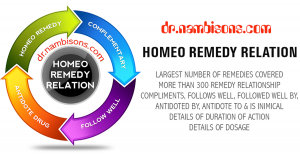
A new app in google play store “Homeo Rem Rel” can be downloaded for free on mobile, and can be used anywhere & the relationship of remedy will be on finger tips.
Merely knowing that a remedy compliments the other is not sufficient. But what is important is, in what symptom or group of symptoms does it compliment the other remedy is necessary to be known. In this anthology I have gone through diverse sources & collected the information, this shall go a long way in placing a lasting reprieve to the sick.
Though Hahnemann has given the indirect concept of relationship of remedies in his books Organon of Medicine and Chronic Disease Their Nature and Cure but Boenninghausen has represented it in a systemic way. So he is considered to be a pioneer of this concept. Later on various stalwarts have tried to explain the same relationship according to their perception.
Now, let us understand different Remedy relationship in Homoeopathic perspective. A relationship is a specific connection between drugs; their relation may be as given in Repertory of Hering’s Guiding Symptoms of our Materia Medica by Calvin B. Knerr, M. D. (Indian ed., v.2, chapter 48, p.1697):
ANTIDOTES: To the effects of massive and molecular doses; chemical antidotes in poisoning; to the lasting or chronic effects superinduced by the drug. (Remedy to counteract the effects of another or Nullifies the effects of previously taken medicine)
COLLATERAL: Side relations (congeners) belonging to the same or allied botanical family or chemical group. (Similar in action)
FOLLOW WELL/COMPATIBLE: Drugs following well. (After previously prescribed medicine compatible medicine is found to act well)
COMPLEMENTARY: Supplying the part of another drug. (Complementary medicine completes the action of previously prescribed medicine) e.g.: Relationship between acute remedies that are often needed and their complementary chronic treatment that is required to finish the case – e.g. belladonna – calc carb.
INIMICAL/INCOMPATIBLE: Drugs disagreeing, incompatible, do not follow well. (If the patient’s condition worsens, when a remedy is given before or after certain other remedy.)
SIMILAR: Drugs suggested for comparison by reason of their similarity; usually compatible, unless too similar, like Nux vomica and Ignatia.
INTERCURRENT REMEDIES: It so happens occasionally that a patient does not react to the best indicated remedy. The administration of certain remedies has been found to help the patient to shake off this “lack of reaction” such remedies are: Carbo-Veg, Conium, Cuprum, Opium, Laurocer, Med, Phos-ac, Psor, Sulphur, Syph, Tuberc., etc
CONCORDANTS: actions of remedy are similar but of dissimilar origin to another. Examples of concordant remedies are China and Calcarea, Pulsatilla and Sepia, Nitric acid and Thuja, Belladonna and Mercurius, Ignatia and Zinc.
Remedy Relationship has been put forth in different ways. Here is some example of relation in the form of Triads given by Dr.Nash & Dr.Kent:
Puls – Sil – Fl-Ac
Ign – Nat – Sep
Sulph – Sars – Sep
Coloc – Caust – Staph
Ars – Thuja – Tarent
All-c – Phos – Sulph
Thuj – Staph – Nit-ac (Warty Trio)
Nit-ac – Benz-ac – Sep (Foul Odor Of Urine Trio)
Carb-v – Ars – Mur-ac (The Corpse Revivers)
Camph – Cupr – Verat-a (Cholera Trio)
Ipecac – Cuprum Met – Veratrum Alb (Collapse in cholera
Ant tart – Opium – Nux Mosch (Drowsiness)
Gelsemium – Causticum – Sepia (Droopy Eyelids)
Carb-an – Con – Brom (Glandular Affections Trio)
Sulphur – Calc Carb – Lycopodium (Skin Anti-psoric)
Sulphur – Merc Sol – Thuja (Anti-Miasmatic)
Carbo Veg – China – Lycopodium (Flatulence)
Arsenicum alb – Phos – Sulphur (Burning Sensation)
Aconite – Chamomilla – Coffea (Pain Sensitivity)
Acon – Ars – Rhus-t (Restless Trio)
Belladonna – Hyoscyamus – Stramonium (Delirium)
Aconite – Ignatia – Opium (Fear)
Ignatia – Nat Mur – Acid Phos (Grief)
Lachesis – Naja – Crotalus (Snake Remedy Trio)
Kali iod – Sanguinaria – Stannum (Cough after pneumonia)
Causticum – Rhus tox – Sulphur (Rheumatism)
Belladonna – Calc Carb – Nat Mur (Upper Lips)
Glonine – Belladonna – Mellilotus (Headaches)
And from Boenninghausen – one not in Nash’s List :
Aconite – Spongia – Hepar sulph (The Croup Powders)
According to Roger Schmidt in Hahnemannian Gleaning, April, 1978
- Acon – Sulph
- Bell – Calc
- Ars – Verat, Thuja, Nat-S
- Bry – Alum, Phos, Nat-M, Kali-C
- Colo – Caust
- Ign – Ant-M, Sep
- Ipec – Cupr, Ant-t, Nat-s
- Lach – Lyc
- Merc – Syph, Thuja, Aurum
- Nit-ac – Sulph
- Nux-v- Sulph, Lyco, Sep, Kali-c
According to Elizabeth Hubbard
- Coloc – Staph
- Bacill – Calc-p
- Hepar sulph – Silicea
- Puls – Silicea

Sir,I had purchased this app few years ago,but after updating of my phone this app is vanished. Kindly help me to download it